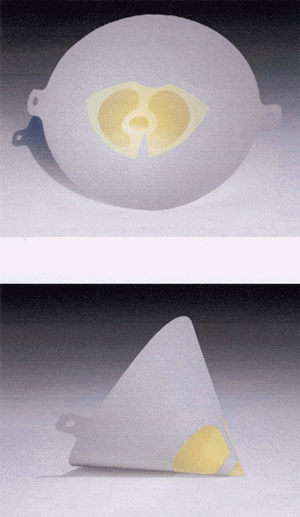Geel puntje
 GvEA, 10 september 2008, zaak T-201/06, Louis M. Gerson Co., Inc tegen OHIM (Nederlandse vertaling nog niet beschikbaar).
GvEA, 10 september 2008, zaak T-201/06, Louis M. Gerson Co., Inc tegen OHIM (Nederlandse vertaling nog niet beschikbaar).
Merkenrecht. Weigering op absolute gronden van 3D gemeenschapsmerk “Paint filter partly coloured yellow”. Beroep afgewezen: geen onderscheidend vermogen. Decoratief en niet orgineel. Freihaltebedürfnis kleurgebruik.
“23. In the present case, as regards the shape of the mark applied for, it must be stated that it is very similar to competing goods on the market. Even if each manufacturer produces different filters, the three-dimensional shape in respect of which registration was applied for is a simple shape which is amongst those which come naturally to the mind of the consumer in relation to paint filters. As the Board of Appeal rightly found at paragraph 17 of the contested decision, the shape at issue does not have any element that can be said to depart perceptibly from one of the most common shapes of such a product.
24. Next, as regards the use of the colour yellow near the tip of the filter, it must be observed that that is not sufficient to warrant the conclusion that the mark applied for enables the average consumer to distinguish the product concerned from those of other undertakings without conducting an analytical examination and without paying particular attention. Thus, the applicant’s argument that the colour would be noticed by users who would therefore identify the trade origin of the product (see paragraph 11 above) cannot be accepted. On the contrary, as the Board of Appeal states at paragraph 17 of the contested decision, the use of the colour yellow will be perceived as indicating the tip or as a decorative element, but not as a distinctive element. The use of the colour might possibly serve to distinguish between the quality or the size of different models of the same product, but is not distinctive as regards its trade origin.
(…) 26. Moreover, even were it the case, as the applicant asserts, that the consumer was a specialist and could be expected to know that only the applicant produced coloured paint filters, the distinctive character of the mark resulting from the application of a colour on the goods could not be accepted. That argument entails registration of the mark being based not on the use of the colour yellow in particular, but on the mere application of a colour on goods. In such circumstances, registration would unduly restrict the availability of colours for competitors, who might wish to use them on their own goods.”
Lees het arrest hier.





















































































